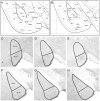The vomeronasal organ is required for the male mouse medial amygdala response to chemical-communication signals, as assessed by immediate early gene expression
- PMID: 19778594
- PMCID: PMC2801006
- DOI: 10.1016/j.neuroscience.2009.09.030
The vomeronasal organ is required for the male mouse medial amygdala response to chemical-communication signals, as assessed by immediate early gene expression
Abstract
Many species use chemical signals to convey information relevant to social and reproductive status between members of the same species (conspecific), but some chemical signals may also provide information to another species (heterospecific). Both of these types of complex chemical signals may be detected by the vomeronasal organ, which sends projections to the accessory olfactory bulb and on to the medial amygdala. Previous reports in hamster and mouse suggest that the medial amygdala sorts this complex chemosensory information categorically, according to its biological relevance (salience). In the present set of experiments, male mice having undergone vomeronasal removal surgery (VNX) or a sham-operation (SHAM) were exposed to conspecific (male and female mouse urine) or heterospecific (hamster vaginal fluid and worn cat collar) chemical stimuli. Similarly to our previous report with intact male mice [Samuelsen and Meredith (2009) Brain Res 1263:33-42], SHAM mice exhibit different immediate early gene (IEG) expression patterns in the medial amygdala dependent upon the biological relevance of the chemical stimuli. However, regardless of biological relevance, vomeronasal organ removal eliminates all responses in the medial amygdala to any of the chemical stimuli. Interestingly, VNX also disrupts the avoidance of (an unfamiliar) predator odor, worn cat collar. Here we show that the medial amygdala response to the tested chemical signals is dependent upon an intact vomeronasal organ.
Figures






Similar articles
-
Characteristic Response to Chemosensory Signals in GABAergic Cells of Medial Amygdala Is Not Driven by Main Olfactory Input.Chem Senses. 2017 Jan;42(1):13-24. doi: 10.1093/chemse/bjw096. Epub 2016 Sep 20. Chem Senses. 2017. PMID: 27651427 Free PMC article.
-
Oxytocin antagonist disrupts male mouse medial amygdala response to chemical-communication signals.Neuroscience. 2011 Apr 28;180:96-104. doi: 10.1016/j.neuroscience.2011.02.030. Epub 2011 Feb 17. Neuroscience. 2011. PMID: 21333718 Free PMC article.
-
Categorization of biologically relevant chemical signals in the medial amygdala.Brain Res. 2009 Mar 31;1263:33-42. doi: 10.1016/j.brainres.2009.01.048. Epub 2009 Feb 5. Brain Res. 2009. PMID: 19368822 Free PMC article.
-
Influence of Cat Odor on Reproductive Behavior and Physiology in the House Mouse: (Mus Musculus).In: Mucignat-Caretta C, editor. Neurobiology of Chemical Communication. Boca Raton (FL): CRC Press/Taylor & Francis; 2014. Chapter 14. In: Mucignat-Caretta C, editor. Neurobiology of Chemical Communication. Boca Raton (FL): CRC Press/Taylor & Francis; 2014. Chapter 14. PMID: 24830030 Free Books & Documents. Review.
-
Pheromones, the vomeronasal system, and communication. From hormonal responses to individual recognition.Ann N Y Acad Sci. 1998 Nov 30;855:333-48. doi: 10.1111/j.1749-6632.1998.tb10592.x. Ann N Y Acad Sci. 1998. PMID: 9929626 Review.
Cited by
-
Intergenerational response to sperm competition risk in an invasive mammal.Proc Biol Sci. 2023 Apr 26;290(1997):20222452. doi: 10.1098/rspb.2022.2452. Epub 2023 Apr 26. Proc Biol Sci. 2023. PMID: 37122257 Free PMC article.
-
Type 2 vomeronasal receptor-A4 subfamily: Potential predator sensors in mice.Genesis. 2024 Apr;62(2):e23597. doi: 10.1002/dvg.23597. Genesis. 2024. PMID: 38590121 Free PMC article. Review.
-
Characteristic Response to Chemosensory Signals in GABAergic Cells of Medial Amygdala Is Not Driven by Main Olfactory Input.Chem Senses. 2017 Jan;42(1):13-24. doi: 10.1093/chemse/bjw096. Epub 2016 Sep 20. Chem Senses. 2017. PMID: 27651427 Free PMC article.
-
Dendritic Organization of Olfactory Inputs to Medial Amygdala Neurons.J Neurosci. 2015 Sep 23;35(38):13020-8. doi: 10.1523/JNEUROSCI.0627-15.2015. J Neurosci. 2015. PMID: 26400933 Free PMC article.
-
Oxytocin antagonist disrupts male mouse medial amygdala response to chemical-communication signals.Neuroscience. 2011 Apr 28;180:96-104. doi: 10.1016/j.neuroscience.2011.02.030. Epub 2011 Feb 17. Neuroscience. 2011. PMID: 21333718 Free PMC article.
References
-
- Blanchard DC, Canteras NS, Markham CM, Pentkowski NS, Blanchard RJ. Lesions of structures showing FOS expression to cat presentation: Effects on responsivity to a Cat, Cat odor, and nonpredator threat. Neurosci Biobehav Rev. 2005;29(8):1243–53. - PubMed
-
- Canteras NS. The medial hypothalamic defensive system: hodological organization and functional implications. Pharmacol Biochem Behav. 2002;71:481–491. - PubMed
-
- Champlin AK, Dorr DL, Gates AH. Determining the stage of the estrous cycle in the mouse by the appearance of the vagina. Biol Reprod. 1973;8:491–494. - PubMed
-
- Chamero P, Marton TF, Logan DW, Flanagan K, Cruz JR, Saghatelian A, Cravatt BF, Stowers L. Identification of protein pheromones that promote aggressive behaviour. Nature. 2007;450(7171):899–902. - PubMed
-
- Choi GB, Dong HW, Murphy AJ, Valenzuela DM, Yancopoulos GD, Swanson LW, Anderson DJ. Lhx6 delineates a pathway mediating innate reproductive behaviors from the amygdala to the hypothalamus. Neuron. 2005;46(4):647–660. - PubMed
Publication types
MeSH terms
Substances
Grants and funding
LinkOut - more resources
Full Text Sources
Miscellaneous

